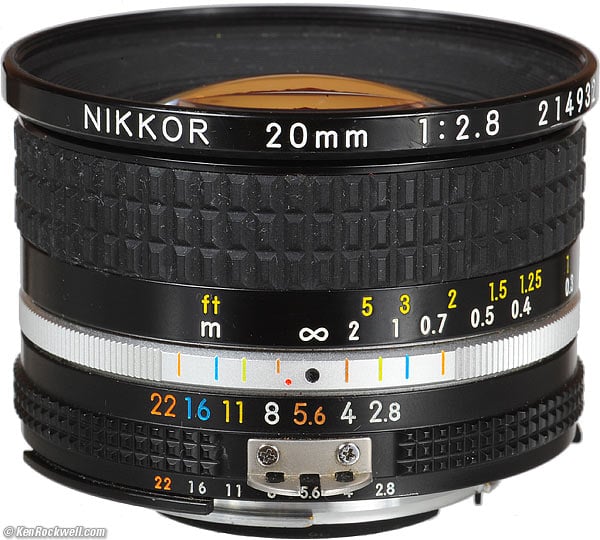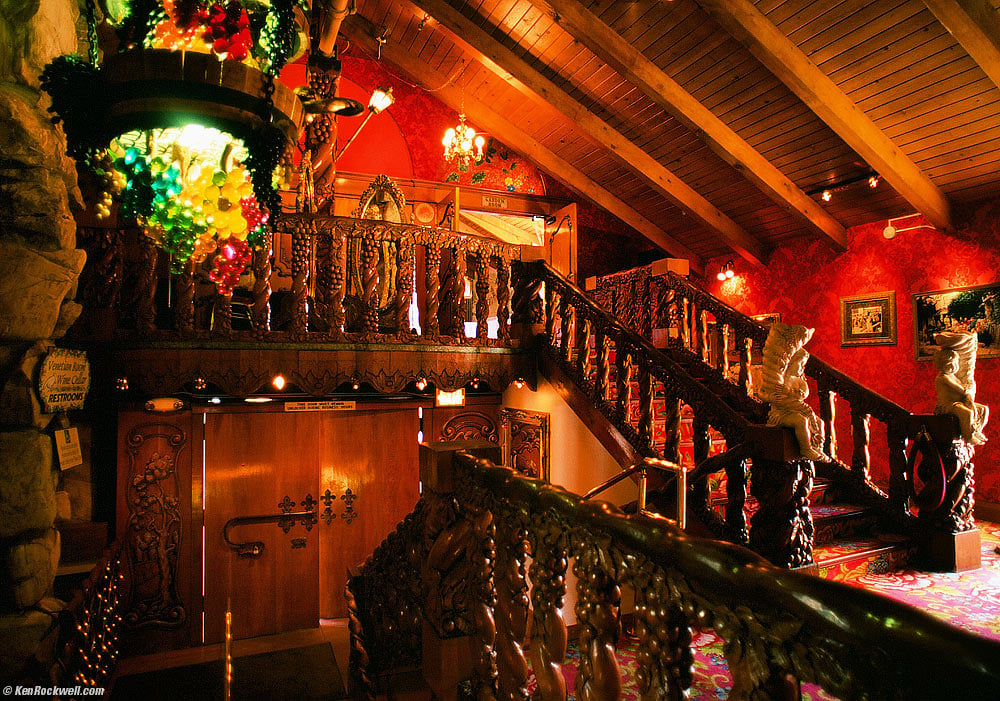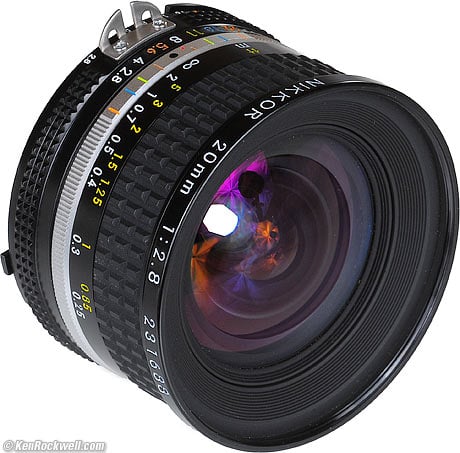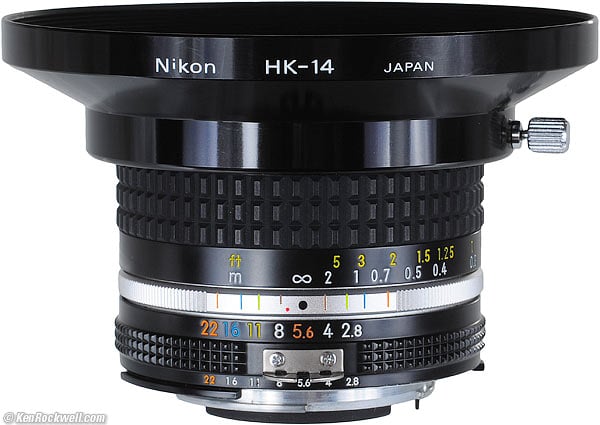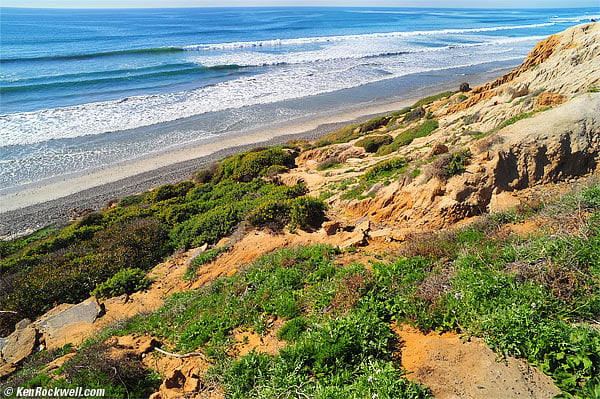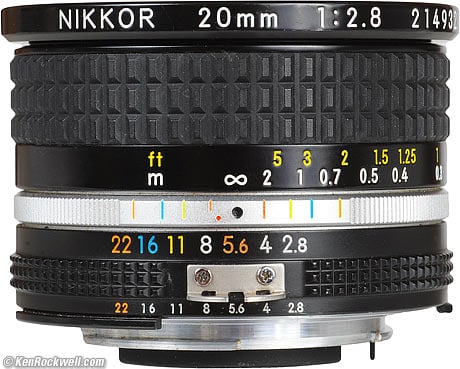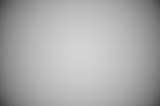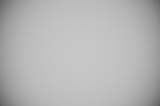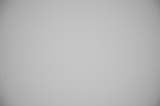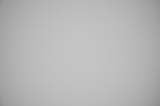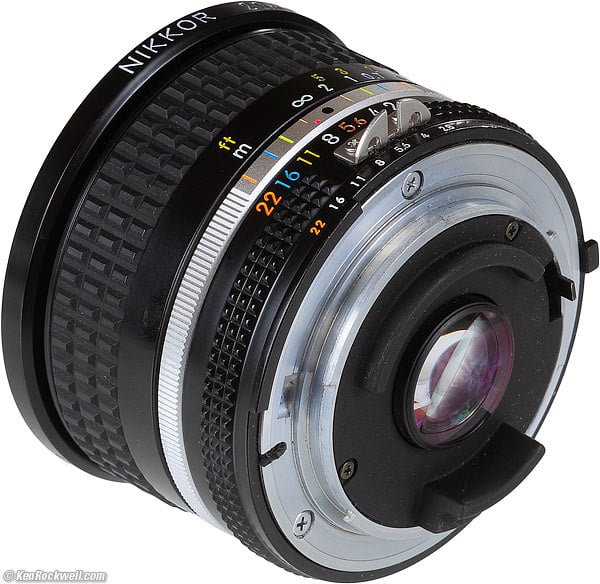Home Donate New Search Gallery Reviews How-To Books Links Workshops About Contact
Nikon
20mm f/2.8
NIKKOR AI-s (1984-2021)
Intro Specifications Performance Compared Recommendations
Nikon 20mm f/2.8 AI-s (62mm filters, 9.1 oz./259g, was $650 brand new or now $350 used.) enlarge. This free website's biggest source of support is when you use any of these links, especially this direct link to this lens at B&H or this link directly to them at eBay (see How to Win at eBay), when you get anything, regardless of the country in which you live. Thanks! Ken.
March 2012, September 2010 More Nikon Reviews Nikon Lenses All Reviews
Sharpness Comparison to other 20mm lenses
Ideal Uses
Superb FX ultrawide, and compact, too. Nikon has never made a faster 20mm lens, and this lens is smaller and lighter than any Nikon ultrawide zoom.
Not for
I wouldn't bother with this on a DX camera. I'd use any DX lens, like the 18-55mm kit lens, instead. As a manual focus lens, I wouldn't use it for sports, kids or action since it's too hard to track focus by hand.
| Optics: | |
| Ergonomics: | |
| Usefulness: | |
| Availability: | |
| Overall: |
Sample Images
Best Western Casa Grande, Arroyo Grande, 9:52 PM, 12 April 2013. bigger. (1977 Nikon EL2, 1990 Nikon 20mm f/2.8 AI-s with no filter, Fuji Velvia 50, f/5.6 at two seconds hand-held while sitting in a comfy chair, process and scan at NCPS, Perfectly Clear.)
Stairs, Madonna Inn, San Luis Obispo, 10:26 AM, 11 April 2012. bigger. (1977 Nikon EL2, 1990 Nikon 20mm f/2.8 AI-s, Nikon A2 (81A) filter, Fuji Velvia 50, f/2.8 at 1 second hand-held (I braced myself on a railing), process and scan at NCPS, Perfectly Clear.
Introduction top
Intro Specifications Performance Compared Recommendations
|
I buy only from these approved sources. I can't vouch for ads below. |
This has been Nikon's most popular manual focus 20mm lens since the 1980s. Nikon still makes them in 2012, and you can buy them brand-new from B&H Photo-Video.
As all of the Nikkor AI-s manual focus lenses, this Nikon 20mm f/2.8 lens represents the highest standard of mechanical precision and durability that Nikon has ever attained.
Nikon also makes this same lens in an autofocus version, the 20mm f/2.8 AF (1989-1994) and 20mm f/2.8 AF-D (1994-today). It uses identical optics in a plasticy package.
The manual-focus Nikon 20mm f/2.8 works great with most Nikon cameras, 35mm and digital.
It works flawlessly with every manual focus Nikon ever made, from the F of 1959 through the FM3a and today's FM-10.
On the D4, D800, D800E, D7000, D3X, D3s, D3, D700, D300, D200, D2, F6 and others, use the "Non-CPU Lens Data" menu option to set 20mm and f/2.8 to get full color matrix metering, EXIF data and finder read-out of set aperture. It works great in aperture-preferred as well as manual modes on these cameras.
It works perfectly on every professional 35mm camera (F, F2, F3, F4, F5, F6), and adds Matrix metering on the FA, F4 and F6.
The meters of cheaper digital (D90, D5000 and below) and cheaper film cameras (N80 and below) will not couple (or work at all) with this lens, so you'll be on your own guessing exposure using the rear LCD or an external meter, or get a tiny Gossen Digisix meter and hot shoe adapter to meter manually.
See Nikon Lens Compatibility for details on your camera. Read down the "AI, AI-s" column for this lens.
Nikon 20mm f/2.8 AI-s. enlarge.
1959-1967
Nikon repackaged their 2.1cm (21mm) f/4 rangefinder lens, originally designed for the Nikon SP, for the F-mount SLRs.
It required the use of mirror lockup and a separate finder slid over the funky rewind crank of the NIkon F, as it poked all the way into the camera.
Nikon made about 5,000 of the 2.1cm f/4 lenses.
1967-1974
The 20mm f/3.5 UD was Nikon's first 20mm lens. It was the ultrawide for the late 1960s and early 1970s. There was no wider non-fisheye lens made by Nikon until the insane 15mm f/5.6 of 1973 and the 18mm f/4 of 1974.
Nikon made about 40,000 of the 20mm f/3.5 UD lenses.
1974-1978
The tiny 20mm f/4 (52mm filters), the smallest ultrawide ever made by Nikon or Canon, replacing the big 20/3.5 UD, with similar optical performance.
In 1975 Nikon introduced the world's widest non-fisheye lens, the Nikkor 13mm f/5.6, which remains today a the world's widest professional SLR lens ever made.
Nikon made F-mount (non-AI) 20mm f/4s from 1974-1977. The mount was redesigned as an AI lens in 1977, and sold until 1978.
Nikon made about 35,000 of these 20mm f/4 lenses, about half AI and half not. Most non-AI lenses have long since been updated to AI.
1977-1984
The 20mm f/3.5 AI lens was introduced in the fall of 1977 as one of the first AI lenses.
The optically identical AI-s version replaced it in the fall of 1981. The AI-s version was made until about 1984, since most people preferred the f/2.8 and bought it instead.
Nikon made about 30,000 of each version, or 60,000 total.
1984-today
Nikon replaced the tiny 20mm f/3.5 with this 20mm f/2.8 in 1984. It takes 62mm filters and is sold today in both this manual-focus AI-s version and autofocus versions.
Nikon has made about 70,000 of the 20mm f/2.8 AI-s lenses as of 2010, and still makes them today.
Nikon has made about 115,000 of the 20mm f/2.8 AF and AF-D lenses as of 2010, and still makes them today.
Specifications top
Intro Specifications Performance Compared Recommendations
Name
Nikon calls this the Nikon NIKKOR 20mm f/2.8 AI-s.
Optics top
12 elements in 9 groups.
Multicoated.
Close-range correction (CRC) floating elements.
Focal Length top
20mm.
Used on a DX camera it gives angles of view similar to what a 30mm lens would give on an FX or 35mm film camera. See also Crop Factor.
Angle of View top
94° on FX and 35mm.
71° on small-format DX.
Diaphragm top
7 blades.
Stops down to f/22.
Close Focus top
0.85 feet (0.25m).
Maximum Reproduction Ratio top
1:8.3.
Depth-of Field Scale top
YES.
Infra-Red Focus Index top
YES, near the f/5.6 depth-of-field index.
Filter Thread top
62mm.
Metal.
Does not rotate.
Size top
1.669" extension from flange by 2.559" diameter (42.40 x 65.00mm), measured.
Nikon specifies 42.5 x 65mm.
Weight top
9.125 oz. (258.75g), measured.
Nikon specifies 260g.
Hood top
Nikon 20mm f/2.8 AI-s and HK-14 slip-on hood. enlarge.
The 20mm f/2.8 takes the HK-14 slip-on hood.
It's a friction fit with a thumb screw.
Nikon Catalog Number top
1415.
Price, USA top
March 2012: about $675 new at B&H, $675 at Nikon, or $350 at eBay.
September 2010: about $600 new at B&H, or $675 at Nikon.
Performance top
Intro Specifications Performance Compared Recommendations
Overall Focus Color Coma Distortion Ergonomics
Falloff Filters Ghosts Color Fringes
Overall
Optically it's a typical Nikon wide-angle: soft in the corners wide-open due to coma, and some light falloff that goes away stopped down.
The barrel distortion is a little more complex than usual: the center of the image has the usual barrel distortion, however it starts to straighten out at the far edges. This makes it measure a little better in tests, but also makes it much more difficult to correct in Photoshop.
Performance is great; used properly, it's sharp and just works.
The only sharper 20mm Nikon lenses are either the 16-35mm or 14-24mm, and then only if you look in the corners at f/4 and f/2.8.
All Nikon's previous 20mm lenses are just as sharp, and oddly also have the same falloff and distortion.
Focus performance top
Manual focus has the exquisite classic Nikon feel, which is duplicated nowhere else.
One light fingertip is all that's required to focus.
Focus is fast. It goes from infinity to 0.85 feet (0.25 meters) in only 90º of rotation.
Color Rendition performance top
Like all Nikon multicoated lenses, I've never seen any variation between any of them in color rendition. They all look the same, the hallmark of a well-designed lens line.
Peripheral color balance is cooler than the center, which is typical for ultra-wide lenses of every brand and format.
I can't see this in real photos, but you will see it in photos of white walls. If it bothers you, get the 14-24mm f/2.8 AFS, which has this effect under better, but not complete, control.
Coma performance top
The 20/2.8 has plenty of saggital coma flare (points of light turning into weird blobs in the corners) at f/2.8, less at f/4, and it's gone by f/5.6.
Distortion performance top
La Jolla Seashore, on FX, uncorrected. Note slight wiggling along top. enlarge.
Distortion is complex on film and FX.
It's simple barrel distortion on DX, with no wiggling.
You may as well leave it along on film and FX, since the correction below doesn't do much to eliminate the complex curve.
On DX, it corrects perfectly, but why use this 20mm lens on DX when the 18-55mm AFS kit lens works so much better?
Plug these figures into Photoshop's lens distortion filter to correct the distortion. These aren't facts or specifications, they are the results of my research that requires hours of data collection and computation.
FX and Film |
||
Infinity |
0.0* |
+3.2 |
3m (10 feet) |
0.0* |
+3.0 |
© 2008 KenRockwell.com
*Wiggling, or waviness, remains.
Ergonomics performance top
Nikon 20mm f/2.8 AI-s. enlarge.
The Nikon 20mm f/2.8's ergonomics are perfect: just one big focus ring, a head to keep your fingers out of your pictures, and a grip and aperture rings at the back.
Bravo!
Falloff (darkened corners) performance top
Falloff is visible at f/2.8, mostly goes away at f/4, and is gone by f/5.6.
Falloff on FX is exactly the same as Nikon's other 20mm lenses and wide zooms.
It won't be an issue at all on DX (see crop factor).
I've exaggerated this by shooting a gray field and placing these on a gray background.
Nikon 20mm f/2.8 AI-s falloff on FX and film at infinity, no correction.
© 2010 KenRockwell.com. All rights reserved.
|
Filters, Use with performance top
There is no problem with vignetting with 62mm filters, so long as you use Nikon brand or other filters which have very thin mounts.
The very thick mounts of most Tiffen, Heliopan and B&W filters may cause some vignetting on film and FX digital, especially with rotating filters.
I use a 62mm -> 77mm step-up ring and 77mm filters, with which the vignetting problem goes away.
Don't use a polarizer; they don't work with well with any 20mm lens because the polarization of nature itself varies over such a broad angle.
Flare and Ghosts performance top
With the disc of the sun in the image, there may be a stream of green ghosts across the image.
Lateral Color Fringes performance top
There are no lateral color fringes on the 12 MP D3, or 24 MP D3X, which would correct them if the lens had any.
Mechanics performance top
Nikon 20mm f/2.8 AI-s. enlarge.
Like all Nikkor manual focus AI-s lenses, the Nikon 20/2.8 AI-s is built to the highest mechanical standards, unlike the dinky plastic AF-D version more popular today.
Barrel Exterior
Anodized and enameled aluminum.
Filter Threads
Anodized aluminum.
HK-14 Hood
Anodized aluminum, painted markings.
Focus Ring
Metal, rubber covered.
Focus Helicoids
Feels like brass: smooth and silky with no play or need for damping grease.
Depth-of-Field Scale
Engraved into barrel and filled with different colors of paint.
Internals
All metal.
Aperture Ring
Cast aluminum, anodized and enameled.
Engraved markings filled with different colors of paint coded to the depth-of-field scale.
Mount
Dull-chromed brass.
Markings
Engraved into the metal and filled with paint.
Identity and Serial Number
Engraved at the front, outside the filter ring, and filled with paint.
Ass-Gasket (dust seal at mount)
No.
Noises When Shaken
Some clucking from the sections of the CRC system floating around.
Made in
Japan.
Sharpness performance top
Warning 1: Image sharpness depends more on you than your lens.
Warning 2: Lens sharpness doesn't mean much to good photographers.
The 20/2.8 AI-s is super-sharp on a 24MP FX D3X when used properly (stopped-down). It's softer at f/2.8, so don't shoot it there if you're counting pixels.
On a 24MP FX Nikon D3X
At f/2.8
Everything is a little soft and dreamy, veiled by spherical aberration.
The corners show a healthy dose of coma.
At f/4
The spherical aberration is gone from the center, which is now sharp and contrasty.
The sides and corners are softer, and the corners show coma.
At f/5.6
The sides perk right up, and are now sharp and contrasty.
The corners are still softer.
At f/8
The corners improve further, and the center is optimum at f/8.
At f/11
The corners are optimum at f/11, while diffraction only slightly reduces center sharpness.
Sunstars performance top
With its classic 7-bladed diaphragm, the 20mm f/2.8's classic 14-pointed sunstars on bright points of light.
Compared top
Intro Specifications Performance Compared Recommendations
Oddly, I carefully compared this to eight other Nikon fixed 20mm and ultrawide zooms, and except for the superior 16-35mm and 14-24mm, they all have pretty much the same sharpness overall!
I compared the 20/3.5 UD, 20/4 AI, 20/3.5 AI, 20/2.8 AI-s, 20/2.8 AF, 20-35mm, 17-35mm, 18-35mm and 14-24mm. Wow! Yes, they were all different, but different in different ways in different places, thus in all, they were each as sharp as the next. (The 16-35mm and 14-24mm were superior, but everything else was the same.)
Sharpness Comparison to other 20mm lenses
| Anni | 2010- |
2009- |
1984- |
1977-1984 |
1974-1978 |
1967-1974 |
| Filter | 77mm |
52mm |
62mm |
52mm |
52mm |
52mm |
| Threads | Plastic |
Metal |
Metal |
Metal |
Metal |
Metal |
| Barrel | Plastic |
Metal |
Metal |
Metal |
Metal |
Metal |
| Weight | 678g |
199.5g |
259g |
232g |
209g |
388g |
| Weight | 23.9 oz. |
7.040 oz. |
9.1 oz. |
8.2 oz. |
7.4 oz. |
13.7 oz. |
| Price, USA, September 2010 |
Recommendations top
Intro Specifications Performance Compared Recommendations
This 20/2.8 AI-s lens is much more sturdily and precisely built than its optically-equivalent AF cousin.
You could save money and get an AF version for use on your manual focus camera if you don't mind the AF lens' sloppier mechanics.
I have seen no major difference in optical performance (sharpness, falloff or distortion) among any of Nikon's fixed 20mm lenses.
The autofocus 20mm can have sloppier corner performance than this AI-s lens due to the sloppy mechanics of the AF version; just try to wiggle the front of an AF and this AI-s lens and you'll see how sloppy is the AF lens by comparison.
Deployment top
I'd pitch the flat Nikon cap that came with these lenses made before about 2008, and get a new 62mm "pinch" type cap. I'm not kidding: the new fatter caps are much easier to use in the field.
I'd leave either a 62mm Nikon Clear (NC - UV) filter, or a 62mm Hoya Super HMC UV on the lens at all times.
For color slides like Velvia 50, I use a 62mm Nikon A2 or a 62mm Hoya HMC 81A outdoors.
For B&W film outdoors, I'd use a 62mm Nikon Y48 or 62mm Hoya HMC K2 Yellow, or 62mm Nikon O56 or 62mm Hoya HMC Orange.
For integration within a larger professional Nikon system, I use a 62mm -> 77mm adapter ring, and treat this as 77mm lens for the sake of my own sanity. If you do, too, forget 62mm filters and caps, and:
Get a new 77mm Nikon front cap.
I'd leave either a 77mm Nikon Clear (NC - UV) filter, or a 77mm Hoya Super HMC UV on the lens at all times.
If I was working in nasty, dirty areas, I'd forget the cap, and use an uncoated 77mm Tiffen UV filter instead. Uncoated filters are much easier to clean, but more prone to ghosting.
For color slides like Velvia 50, I use a 77mm Hoya HMC 81A or Nikon A2 filter outdoors.
For B&W film outdoors, I'd use a 77mm Hoya HMC Yellow K2 or 77mm Hoya HMC Orange.
© Ken Rockwell. All rights reserved. Tous droits réservés. Alle Rechte vorbehalten. Alla rättigheter förbehållna. Toate drepturile rezervate. Ken Rockwell® is a registered trademark.
Help Me Help You top
I support my growing family through this website, as crazy as it might seem.
The biggest help is when you use any of these links when you get anything. It costs you nothing, and is this site's, and thus my family's, biggest source of support. These places always have the best prices and service, which is why I've used them since before this website existed. I recommend them all personally.
If you find this page as helpful as a book you might have had to buy or a workshop you may have had to take, feel free to help me continue helping everyone.
If you've gotten your gear through one of my links or helped otherwise, you're family. It's great people like you who allow me to keep adding to this site full-time. Thanks!
If you haven't helped yet, please do, and consider helping me with a gift of $5.00.
As this page is copyrighted and formally registered, it is unlawful to make copies, especially in the form of printouts for personal use. If you wish to make a printout for personal use, you are granted one-time permission only if you PayPal me $5.00 per printout or part thereof. Thank you!
Thanks for reading!
Ken.
